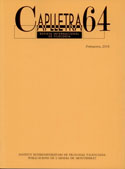Nominal encapsulation in oral and written academic discourse: grammatical and discourse patterns
DOI:
https://doi.org/10.7203/caplletra.64.11369Keywords:
nominal encapsulation, discourse labels, mode, oral, written, discourse pattern, academic discourse Abstract
Abstract
The following article discusses nominal unfaithful encapsulation on a corpus of Spanish conference presentations and the corresponding Proceedings articles in Linguistics (102 903 words). A nominal unfaithful encapsulator is a noun which sums up the content of a predicative portion of text and categorizes it as a discourse entity. This cohesive strategy is commonly used in lexico-grammatical patterns such as postnominal clause patterns (the fact that/to…), attributive complementing clause patterns (the fact is that/to…) or in discourse patterns such as anaphoric attributive pattern, rhematic pattern, thematic pattern and interpretative framework pattern. This study analyses the functions and frequency of these patterns in oral and written research genres. Results show that some of these patterns are more widely used in one of these two modes of communication. It is also argued that some of these encapsulators are attracted to some of these patterns, thus demonstrating the existence of close relationships between lexis and discourse grammar.
 Downloads
Downloads
Downloads
Published
How to Cite
-
Abstract1087
-
PDF (Español)589
Issue
Section
License
Authors submitting work to Caplletra for publication must be the legitimate holder of the usage rights. Legitimacy for the purposes of publishing the work must also include images, tables, diagrams and any other materials that may complement the text, whether they are the author of such material or not.
Copyright: on publishing their work in the journal, the author grants Caplletra. Revista Internacional de Filologia usage rights (reproduction, distribution and public communication) for both the paper printed version and for the electronic version.
All work published in Caplletra is covered by the Creative Commons license type Attribution-NonCommercial-NoDerivatives 4.0 (CC BY-NC-ND 4.0).
RESPONSABILITY
Caplletra. Revista Internacional de Filologia does not necessarily identify with the points of view expressed in the papers it publishes.
Caplletra. Revista Internacional de Filologia accepts no responsibility whatsoever for any eventual infringement of intellectual property rights on the part of authors.






